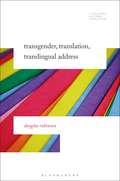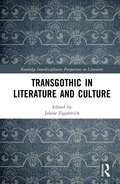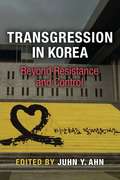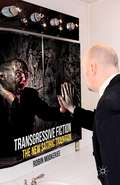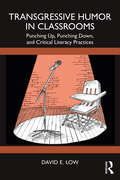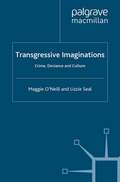- Table View
- List View
Transgender, Translation, Translingual Address: Holy Places In Louisiana (Literatures, Cultures, Translation)
by Douglas RobinsonThe emergence of transgender communities into the public eye over the past few decades has brought some new understanding, but also renewed outbreaks of violent backlash. In Transgender, Translation, Translingual Address Douglas Robinson seeks to understand the “translational” or “translingual” dialogues between cisgendered and transgendered people. Drawing on a wide range of LGBT scholars, philosophers, sociologists, sexologists, and literary voices, Robinson sets up cis-trans dialogues on such issues as “being born in the wrong body,” binary vs. anti-binary sex/gender identities, and the nature of transition and transformation. Prominent voices in the book include Kate Bornstein, C. Jacob Hale, and Sassafras Lowrey.The theory of translation mobilized in the book is not the traditional equivalence-based one, but Callon and Latour's sociology of translation as “speaking for someone else,” which grounds the study of translation in social pressures to conform to group norms. In addition, however, Robinson translates a series of passages from Finnish trans novels into English, and explores the “translingual address” that emerges when those English translations are put into dialogue with cis and trans scholars.
TransGothic in Literature and Culture (Routledge Interdisciplinary Perspectives on Literature)
by Jolene ZigarovichThis book contributes to an emerging field of study and provides new perspectives on the ways in which Gothic literature, visual media, and other cultural forms explicitly engage gender, sexuality, form, and genre. The collection is a forum in which the ideas of several well-respected critics converge, producing a breadth of knowledge and a diversity of subject areas and methodologies. It is concerned with several questions, including: How can we discuss Gothic as a genre that crosses over boundaries constructed by a culture to define and contain gender and sexuality? How do transgender bodies specifically mark or disrupt this boundary crossing? In what ways does the Gothic open up a plural narrative space for transgenre explorations, encounters, and experimentation? With this, the volume’s chapters explore expected categories such as transgenders, transbodies, and transembodiments, but also broader concepts that move through and beyond the limits of gender identity and sexuality, such as transhistories, transpolitics, transmodalities, and transgenres. Illuminating such areas as the appropriation of the trans body in Gothic literature and film, the function of trans rhetorics in memoir, textual markers of transgenderism, and the Gothic’s transgeneric qualities, the chapters offer innovative, but not limited, ways to interpret the Gothic. In addition, the book intersects with but also troubles non-trans feminist and queer readings of the Gothic. Together, these diverse approaches engage the Gothic as a definitively trans subject, and offer new and exciting connections and insights into Gothic, Media, Film, Narrative, and Gender and Sexuality Studies.
TransGothic in Literature and Culture (Routledge Interdisciplinary Perspectives on Literature)
by Jolene ZigarovichThis book contributes to an emerging field of study and provides new perspectives on the ways in which Gothic literature, visual media, and other cultural forms explicitly engage gender, sexuality, form, and genre. The collection is a forum in which the ideas of several well-respected critics converge, producing a breadth of knowledge and a diversity of subject areas and methodologies. It is concerned with several questions, including: How can we discuss Gothic as a genre that crosses over boundaries constructed by a culture to define and contain gender and sexuality? How do transgender bodies specifically mark or disrupt this boundary crossing? In what ways does the Gothic open up a plural narrative space for transgenre explorations, encounters, and experimentation? With this, the volume’s chapters explore expected categories such as transgenders, transbodies, and transembodiments, but also broader concepts that move through and beyond the limits of gender identity and sexuality, such as transhistories, transpolitics, transmodalities, and transgenres. Illuminating such areas as the appropriation of the trans body in Gothic literature and film, the function of trans rhetorics in memoir, textual markers of transgenderism, and the Gothic’s transgeneric qualities, the chapters offer innovative, but not limited, ways to interpret the Gothic. In addition, the book intersects with but also troubles non-trans feminist and queer readings of the Gothic. Together, these diverse approaches engage the Gothic as a definitively trans subject, and offer new and exciting connections and insights into Gothic, Media, Film, Narrative, and Gender and Sexuality Studies.
Transgression: Identity, Space, Time (Transitions)
by Julian WolfreysJulian Wolfreys introduces students to the central concept of transgression, showing how to interpret the concept from a number of theoretical standpoints. He demonstrates how texts from different cultural and historical periods can be read to examine the workings of 'transgression' and the way in which it has changed over time.
Transgression: Identity, Space, Time (Transitions)
by Julian WolfreysJulian Wolfreys introduces students to the central concept of transgression, showing how to interpret the concept from a number of theoretical standpoints. He demonstrates how texts from different cultural and historical periods can be read to examine the workings of 'transgression' and the way in which it has changed over time.
Transgression and Deviance in the Ancient World
by Lennart Gilhaus Anja Dorn Imogen Herrad Michael MeurerSocial coexistence is made possible and regulated by norms. Which actions are labeled and sanctioned as transgressions of norms is the result of social negotiation processes. Transgression and norm deviance can both stabilize and undermine the existing norm system. The contributions to this anthology aim to provide some impulses on the relationship between norm and deviance in ancient societies by means of selected case studies from the Greek classical period to the Roman imperial period and to investigate the role of transgressive acts for the dynamics of social systems. In 8 contributions, among others on the cult of Artemis, on the tragedian Agathon, on Cicero, Lucan and Tacitus, the topic is treated in a model-like manner.
Transgression and Redemption in American Fiction (Oxford Studies in American Literary History)
by Thomas J. FerraroTransgression and Redemption in American Fiction is a critical study of classic American novels. Ferraro returns to Hawthorne's closet of secreted sin to reveal The Scarlet Letter as a deviously psychological turn on the ancient Meditererranean Catholic folk tales of female wanderlust, cuckolding priests, and demonic revenge. This lights the way to explore what Ferraro calls "the Protestant temptation to Marian Catholicism" in seven modern American masterworks, including Chopin's The Awakening, Fitzgerald's The Great Gatsby, Cather's The Professor's House, and Hemingway's The Sun Also Rises. Transgression and Redemption in American Fiction explores stories of forbidden passion and sacrificial violence, with ultra-radiant women (and sometimes men) at their focus. It examines how these novels speak to readers across religious and social spectrums, generating an inclusive mode of address and near-universal relevance. Ferraro breaks the codes of contemporary criticism in his thematic focus and critical style, going beyond Protestantism and even Judeo-Christian Orthodoxy itself. Transgression and Redemption in American Fiction encourages the attentive reader to think about the American imagination, the myriad arts of writing about the passion plays of love, and even our canonical structures for reading and thinking about literature in new ways.
Transgression and Redemption in American Fiction (Oxford Studies in American Literary History)
by Thomas J. FerraroTransgression and Redemption in American Fiction is a critical study of classic American novels. Ferraro returns to Hawthorne's closet of secreted sin to reveal The Scarlet Letter as a deviously psychological turn on the ancient Meditererranean Catholic folk tales of female wanderlust, cuckolding priests, and demonic revenge. This lights the way to explore what Ferraro calls "the Protestant temptation to Marian Catholicism" in seven modern American masterworks, including Chopin's The Awakening, Fitzgerald's The Great Gatsby, Cather's The Professor's House, and Hemingway's The Sun Also Rises. Transgression and Redemption in American Fiction explores stories of forbidden passion and sacrificial violence, with ultra-radiant women (and sometimes men) at their focus. It examines how these novels speak to readers across religious and social spectrums, generating an inclusive mode of address and near-universal relevance. Ferraro breaks the codes of contemporary criticism in his thematic focus and critical style, going beyond Protestantism and even Judeo-Christian Orthodoxy itself. Transgression and Redemption in American Fiction encourages the attentive reader to think about the American imagination, the myriad arts of writing about the passion plays of love, and even our canonical structures for reading and thinking about literature in new ways.
Transgression and Subversion: Gender in the Picaresque Novel (Gender Studies)
by Maren Lickhardt Gregor Schuhen Hans Rudolf VeltenIs the pícaro, the roguish hero of early modern Spanish adventure fiction, a 'real man'? What position does he hold in the gender hierarchy of his fictional social context? Why is the pícara so 'non-female'? What effect has her gender constitution on her fictional social context? In terms of a gendered subject, the picaresque figure has hardly been analyzed so far. Although scholars have recognized it as a transgressive and subversive model, the 'queer' effect of the figure is yet to be examined. With regard to the categories of class, generation, topography, and gender, the contributions assembled in this volume explore Spanish, French, English, and German novels narratologically from the perspective of culture and gender theories.
Transgression in Korea: Beyond Resistance and Control (Perspectives On Contemporary Korea)
by Juhn Young AhnSince the turn of the millennium South Korea has continued to grapple with transgressions that shook the nation to its core. Following the serial killings of Korea’s raincoat killer, the events that led to the dissolution of the United Progressive Party, the criminal negligence of the owner and also the crew members of the sunken Sewol Ferry, as well as the political scandals of 2016, there has been much public debate about morality, transparency, and the law in South Korea. Yet, despite its prevalence in public discourse, transgression in Korea has not received proper scholarly attention. Transgression in Korea challenges the popular conceptions of transgression as resistance to authority, the collapse of morality, and an attempt at self- empowerment. Examples of transgression from premodern, modern, and contemporary Korea are examined side by side to underscore the possibility of reading transgression in more ways than one. These examples are taken from a devotional screen from medieval Korea, trickster tales from the late Choson period, reports about flesheating humans, newspaper articles about same- sex relationships from colonial Korea, and films about extramarital affairs, wayward youths, and a vengeful vigilante. Bringing together specialists from various disciplines such as history, art history, anthropology, premodern literature, religion, and fi lm studies, the context- sensitive readings of transgression provided in this book suggest that transgression and authority can be seen as forming something other than an antagonistic relationship.
Transgression und Devianz in der antiken Welt (Schriften zur Alten Geschichte)
by Lennart Gilhaus Imogen Herrad Michael Meurer Anja PfeifferDurch Normen wird gesellschaftliches Zusammenleben ermöglicht und reguliert. Welche Handlungen als Transgressionen von Normen etikettiert und sanktioniert werden, ist das Resultat sozialer Aushandlungsprozesse. Transgression und Normdevianz können dabei sowohl das bestehende Normsystem stabilisieren als auch unterminieren. Die Beiträge dieses Sammelbandes wollen anhand ausgewählter Fallstudien von der griechischen Klassik bis in die römische Kaiserzeit einige Impulse zum Verhältnis von Norm und Devianz in antiken Gesellschaften liefern und die Rolle von transgressiven Akten für die Dynamik gesellschaftlicher Systeme untersuchen. In 8 Beiträgen u.a. zum Artemiskult, zu dem Tragiker Agathon, zu Cicero, Lucan und Tacitus wird das Thema modellhaft verhandelt.
Transgressive Fiction: The New Satiric Tradition
by R. MookerjeeOften dismissed as sensationalist, transgressive fiction is a sophisticated movement with roots in Menippean satire and the Rabelaisian carnal folk sensibility praised by Bakhtin. This study, the first of its kind, provides a thorough literary background and analysis of key transgressive authors such as Acker, Amis, Carter, Ellis, and Palahniuk.
Transgressive Humor in Classrooms: Punching Up, Punching Down, and Critical Literacy Practices
by David E. LowIn this innovative book, David E. Low examines the multifaceted role of humor in critical literacy studies. Talking about how teachers and students negotiate understandings of humor and social critique vis-à-vis school-based critical literacy curriculums, the book co-examines teachers’ and students’ understandings of humor and critique in schools.Critical literacy centers discussions on power and social roles but often overlooks how students use transgressive humor as a means to interrogate power. Through examples of classroom interactions and anecdotes, Low analyzes the role of humor in classroom settings to uncover how humor interplays with critical inquiry, sensemaking, and nonsense-making. Articulated across the fields of literacy studies and humor studies, the book uses ethnographic data from three Central California high schools to establish linkages and dissonances between critical literacy education and adolescents’ joking practices. Adopting the dialectic of punching up and punching down as a conceptual framework, the book argues that developing more nuanced understandings of transgressive humor presents educators with opportunities to cultivate deeper critical literacy pedagogies and that doing so is a matter of social justice.Essential for scholars and students in literacy education, this book adds to the scholarship on critical literacy by exploring the subversive power of humor in the classroom.
Transgressive Humor in Classrooms: Punching Up, Punching Down, and Critical Literacy Practices
by David E. LowIn this innovative book, David E. Low examines the multifaceted role of humor in critical literacy studies. Talking about how teachers and students negotiate understandings of humor and social critique vis-à-vis school-based critical literacy curriculums, the book co-examines teachers’ and students’ understandings of humor and critique in schools.Critical literacy centers discussions on power and social roles but often overlooks how students use transgressive humor as a means to interrogate power. Through examples of classroom interactions and anecdotes, Low analyzes the role of humor in classroom settings to uncover how humor interplays with critical inquiry, sensemaking, and nonsense-making. Articulated across the fields of literacy studies and humor studies, the book uses ethnographic data from three Central California high schools to establish linkages and dissonances between critical literacy education and adolescents’ joking practices. Adopting the dialectic of punching up and punching down as a conceptual framework, the book argues that developing more nuanced understandings of transgressive humor presents educators with opportunities to cultivate deeper critical literacy pedagogies and that doing so is a matter of social justice.Essential for scholars and students in literacy education, this book adds to the scholarship on critical literacy by exploring the subversive power of humor in the classroom.
Transgressive Humor of American Women Writers
by Sabrina Fuchs AbramsThis collection is the first to focus on the transgressive and transformative power of American female humorists. It explores the work of authors and comediennes such as Carolyn Wells, Lucille Clifton, Mary McCarthy, Lynne Tillman, Constance Rourke, Roz Chast, Amy Schumer and Samantha Bee, and the ways in which their humor challenges gendered norms and assumptions through the use of irony, satire, parody, and wit. The chapters draw from the experiences of women from a variety of racial, class, and gender identities and encompass a variety of genres and comedic forms including poetry, fiction, prose, autobiography, graphic memoir, comedic performance, and new media. Transgressive Humor of American Women Writers will appeal to a general educated readership as well as to those interested in women’s and gender studies, humor studies, urban studies, American literature and cultural studies, and media studies.
Transgressive Humor of American Women Writers
by Sabrina Fuchs AbramsThis collection is the first to focus on the transgressive and transformative power of American female humorists. It explores the work of authors and comediennes such as Carolyn Wells, Lucille Clifton, Mary McCarthy, Lynne Tillman, Constance Rourke, Roz Chast, Amy Schumer and Samantha Bee, and the ways in which their humor challenges gendered norms and assumptions through the use of irony, satire, parody, and wit. The chapters draw from the experiences of women from a variety of racial, class, and gender identities and encompass a variety of genres and comedic forms including poetry, fiction, prose, autobiography, graphic memoir, comedic performance, and new media. Transgressive Humor of American Women Writers will appeal to a general educated readership as well as to those interested in women’s and gender studies, humor studies, urban studies, American literature and cultural studies, and media studies.
Transgressive Imaginations: Crime, Deviance and Culture (Critical Criminological Perspectives)
by M. O'Neill L. SealThis book focuses upon the breaking of rules and taboos involved in 'doing crime', including violent crime as represented in fictive texts and ethnographic research. It includes chapters on topics of urgent contemporary interest such as asylum seekers, sex work, serial killers, school shooters, crimes of poverty and understandings of 'madness'.
Transgressive Theatricality, Romanticism, and Mary Wollstonecraft
by Lisa Plummer CraftonThroughout her works, Mary Wollstonecraft interrogates and represents the connected network of theater, culture, and self-representation, in what Lisa Plummer Crafton argues is a conscious appropriation of theater in its literal, cultural, and figurative dimensions. Situating Wollstonecraft within early Romantic debates about theatricality, she explores Wollstonecraft's appropriation of, immersion in, and contributions to these debates within the contexts of philosophical arguments about the utility of theater and spectacle; the political discourse of the French Revolution; juridical transcripts of treason and civil divorce trials; and the spectacle of the female actress in performance, as typified by Sarah Siddons and her compelling connections to Wollstonecraft on and off stage. As she considers Wollstonecraft's contributions to competing notions of the theatrical, from the writer's earliest literary reviews and translations through her histories, correspondence, nonfiction, and novels, Crafton traces the trajectory of Wollstonecraft's conscious appropriation of the trope and her emphasis on theatricality's transgressive potential for self-invention. Crafton's book, the first wide-ranging study of theatricality in the works of Wollstonecraft, is an important contribution to current reconsiderations of the earlier received wisdom about Romantic anti-theatricality, to historicist revisions of the performance and theory of Sarah Siddons, and to theories of spectacle and gender.
Transgressive Theatricality, Romanticism, and Mary Wollstonecraft
by Lisa Plummer CraftonThroughout her works, Mary Wollstonecraft interrogates and represents the connected network of theater, culture, and self-representation, in what Lisa Plummer Crafton argues is a conscious appropriation of theater in its literal, cultural, and figurative dimensions. Situating Wollstonecraft within early Romantic debates about theatricality, she explores Wollstonecraft's appropriation of, immersion in, and contributions to these debates within the contexts of philosophical arguments about the utility of theater and spectacle; the political discourse of the French Revolution; juridical transcripts of treason and civil divorce trials; and the spectacle of the female actress in performance, as typified by Sarah Siddons and her compelling connections to Wollstonecraft on and off stage. As she considers Wollstonecraft's contributions to competing notions of the theatrical, from the writer's earliest literary reviews and translations through her histories, correspondence, nonfiction, and novels, Crafton traces the trajectory of Wollstonecraft's conscious appropriation of the trope and her emphasis on theatricality's transgressive potential for self-invention. Crafton's book, the first wide-ranging study of theatricality in the works of Wollstonecraft, is an important contribution to current reconsiderations of the earlier received wisdom about Romantic anti-theatricality, to historicist revisions of the performance and theory of Sarah Siddons, and to theories of spectacle and gender.
Transhumanism and Posthumanism in Twenty-First Century Narrative (Perspectives on the Non-Human in Literature and Culture)
by Sonia Baelo-AlluéTranshumanism and Posthumanism in Twenty-First Century Narrative brings together fifteen scholars from five different countries to explore the different ways in which the posthuman has been addressed in contemporary culture and more specifically in key narratives, written in the second decade of the 21st century, by Dave Eggers, William Gibson, John Shirley, Tom McCarthy, Jeff Vandermeer, Don DeLillo, Margaret Atwood, Cixin Liu and Helen Marshall. Some of these works engage in the premises and perils of transhumanism, while others explore the qualities of the (post)human in a variety of dystopian futures marked by the planetary influence of human action. From a critical posthumanist perspective that questions anthropocentrism, human exceptionalism and the centrality of the ‘human’ subject in the era of the Anthropocene, the scholars in this collection analyse the aesthetic choices these authors make to depict the posthuman and its aftereffects.
Transhumanism and Posthumanism in Twenty-First Century Narrative (Perspectives on the Non-Human in Literature and Culture)
by Sonia Baelo-Allué Mónica Calvo-PascualTranshumanism and Posthumanism in Twenty-First Century Narrative brings together fifteen scholars from five different countries to explore the different ways in which the posthuman has been addressed in contemporary culture and more specifically in key narratives, written in the second decade of the 21st century, by Dave Eggers, William Gibson, John Shirley, Tom McCarthy, Jeff Vandermeer, Don DeLillo, Margaret Atwood, Cixin Liu and Helen Marshall. Some of these works engage in the premises and perils of transhumanism, while others explore the qualities of the (post)human in a variety of dystopian futures marked by the planetary influence of human action. From a critical posthumanist perspective that questions anthropocentrism, human exceptionalism and the centrality of the ‘human’ subject in the era of the Anthropocene, the scholars in this collection analyse the aesthetic choices these authors make to depict the posthuman and its aftereffects.
Transiciones: Pathways of Latinas and Latinos Writing in High School and College
by Todd RueckerTransiciones is a thorough ethnography of seven Latino students in transition between high school and community college or university. Data gathered over two years of interviews with the students, their high school English teachers, and their writing teachers and administrators at postsecondary institutions reveal a rich picture of the conflicted experience of these students as they attempted to balance the demands of schooling with a variety of personal responsibilities. Todd Ruecker explores the disconnect between students’ writing experiences in high school and higher education and examines the integral role that writing plays in college. Considering the almost universal requirement that students take a writing class in their critical first year of college, he contends that it is essential for composition researchers and teachers to gain a fuller understanding of the role they play in supporting and hindering Latina and Latino students’ transition to college. Arguing for situating writing programs in larger discussions of high school/college alignment, student engagement, and retention, Transiciones raises the profile of what writing programs can do while calling composition teachers, administrators, and scholars to engage in more collaboration across the institution, across institutions, and across disciplines to make the transition from high school to college writing more successful for this important group of students.
Transition and Continuity in School Literacy Development
by Christine Edwards-Groves Erika Matruglio Pauline JonesThis book addresses a significant gap in the research literature on transitions across the school years: the continuities and discontinuities in school literacy education and their implications for practice. Across different curriculum domains, and using social semiotic, ethnographic, and conversation-analytic approaches, the contributors investigate key transition points for individual students' literacy development, elements of literacy knowledge that are at stake at each of these points, and variability in students' experiences. Grounding its discussion in classroom voices, experiences and texts, this book reveals literacy-specific curriculum demands and considers how teachers and students experience and account for these evolving demands.The contributors include a number of established names (such as Freebody, Derewianka, Myhill, Rowsell, Moje and Lefstein), as well as emerging scholars gaining increasing recognition in the field. They draw out implications for how literacy development is theorized in school curriculum and practice, teacher education, further research and policy formation. In addition, each section of the book features a summary from an international scholar who draws together key ideas from the section and relates these to their current thinking. They deploy a range of different theoretical and methodological approaches in order to bring rich yet complementary perspectives to bear on the issue of literacy transition.
Transition and Continuity in School Literacy Development
by Pauline Jones, Erika Matruglio, Christine Edwards-GrovesThis book addresses a significant gap in the research literature on transitions across the school years: the continuities and discontinuities in school literacy education and their implications for practice. Across different curriculum domains, and using social semiotic, ethnographic, and conversation-analytic approaches, the contributors investigate key transition points for individual students' literacy development, elements of literacy knowledge that are at stake at each of these points, and variability in students' experiences. Grounding its discussion in classroom voices, experiences and texts, this book reveals literacy-specific curriculum demands and considers how teachers and students experience and account for these evolving demands.The contributors include a number of established names (such as Freebody, Derewianka, Myhill, Rowsell, Moje and Lefstein), as well as emerging scholars gaining increasing recognition in the field. They draw out implications for how literacy development is theorized in school curriculum and practice, teacher education, further research and policy formation. In addition, each section of the book features a summary from an international scholar who draws together key ideas from the section and relates these to their current thinking. They deploy a range of different theoretical and methodological approaches in order to bring rich yet complementary perspectives to bear on the issue of literacy transition.
Transition and Transgression: English Young Adult Fiction in Post-Apartheid South Africa (SpringerBriefs in Education)
by Judith InggsThis book conveys the story of a society in the throes of restructuring itself and struggling to find a new identity. A particularly attractive aspect of this study is the focus on young adult literature and its place in post-apartheid South Africa, as well as its potential use in the classroom and lecture hall. Intersecting these two topics provides a compelling lens for refocusing debate on young adult fiction while offering a new and novel angle on debates in South Africa after the end of apartheid. The multilingual and multicultural South African society has resulted in fiction that differs from other parts of the English-speaking world. This work presents a holistic critique of South African young adult fiction and addresses issues such as change and transformation, identity politics, sexuality, and the issue of the right of white writers to represent and “write” characters of different races.
